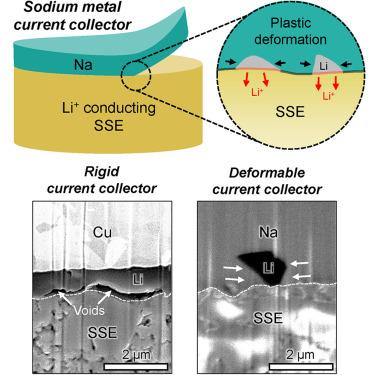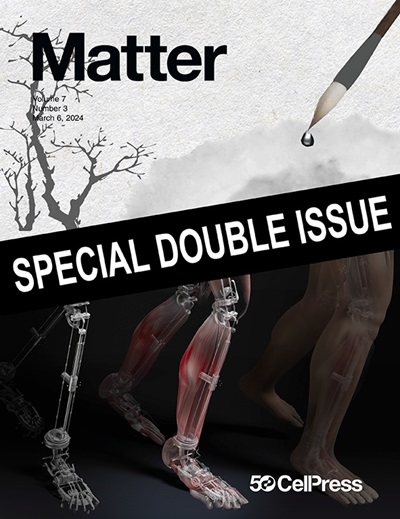Deformable sodium metal current collectors for lithium solid-state batteries
IF 17.5
1区 材料科学
Q1 MATERIALS SCIENCE, MULTIDISCIPLINARY
引用次数: 0
Abstract
Anode-free solid-state batteries could enhance energy density by eliminating excess Li metal from the battery cell. However, their performance is hindered by exacerbated contact loss at the deposited Li/solid-state electrolyte interface. Here, we introduce the use of a plastically deformable current collector to accommodate morphological irregularities during Li deposition and stripping by employing mechanically soft Na metal. The Na metal current collector is shown to establish and maintain conformal interfacial contact with both the solid-state electrolyte and the dynamically evolving Li layer. This behavior enables highly reversible Li plating and stripping on the Na current collector in cells with both Li and LiNi0.6Co0.2Mn0.2O2 counter electrodes, demonstrating superior performance compared to conventional Cu current collectors. Our findings offer a new materials design paradigm for anode-free batteries, replacing the prevailing strategy of using hard current collectors that constrain Li growth with soft current collectors to allow Li morphology to freely evolve.

用于锂固态电池的可变形钠金属集流器
无阳极固态电池可以通过消除电池中多余的锂金属来提高能量密度。然而,在沉积的锂/固态电解质界面上,接触损耗加剧阻碍了它们的性能。在这里,我们介绍了一种塑料可变形电流集电极的使用,以适应在Li沉积和剥离过程中使用机械软Na金属的形态不规则性。结果表明,Na金属集流器可以与固态电解质和动态发展的Li层建立并保持共形界面接触。这种行为使得在具有Li和LiNi0.6Co0.2Mn0.2O2对电极的电池中,在Na电流集热器上实现了高度可逆的Li电镀和剥离,与传统的Cu电流集热器相比,表现出优越的性能。我们的研究结果为无阳极电池提供了一种新的材料设计范式,取代了使用硬集流器限制锂生长的主流策略,用软集流器允许锂形态自由发展。
本文章由计算机程序翻译,如有差异,请以英文原文为准。
求助全文
约1分钟内获得全文
求助全文
来源期刊

Matter
MATERIALS SCIENCE, MULTIDISCIPLINARY-
CiteScore
26.30
自引率
2.60%
发文量
367
期刊介绍:
Matter, a monthly journal affiliated with Cell, spans the broad field of materials science from nano to macro levels,covering fundamentals to applications. Embracing groundbreaking technologies,it includes full-length research articles,reviews, perspectives,previews, opinions, personnel stories, and general editorial content.
Matter aims to be the primary resource for researchers in academia and industry, inspiring the next generation of materials scientists.
 求助内容:
求助内容: 应助结果提醒方式:
应助结果提醒方式:


